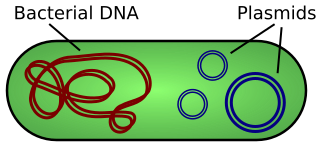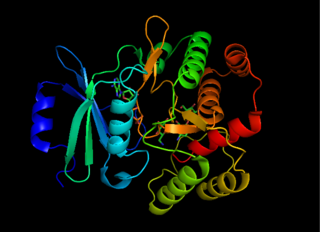
A plasmid is a small, extrachromosomal DNA molecule within a cell that is physically separated from chromosomal DNA and can replicate independently. They are most commonly found as small circular, double-stranded DNA molecules in bacteria; however, plasmids are sometimes present in archaea and eukaryotic organisms. Plasmids often carry useful genes, such as antibiotic resistance and virulence. While chromosomes are large and contain all the essential genetic information for living under normal conditions, plasmids are usually very small and contain additional genes for special circumstances.

Neomycin is an aminoglycoside antibiotic that displays bactericidal activity against Gram-negative aerobic bacilli and some anaerobic bacilli where resistance has not yet arisen. It is generally not effective against Gram-positive bacilli and anaerobic Gram-negative bacilli. Neomycin comes in oral and topical formulations, including creams, ointments, and eyedrops. Neomycin belongs to the aminoglycoside class of antibiotics that contain two or more amino sugars connected by glycosidic bonds.

Gentamicin is an aminoglycoside antibiotic used to treat several types of bacterial infections. This may include bone infections, endocarditis, pelvic inflammatory disease, meningitis, pneumonia, urinary tract infections, and sepsis among others. It is not effective for gonorrhea or chlamydia infections. It can be given intravenously, by intramuscular injection, or topically. Topical formulations may be used in burns or for infections of the outside of the eye. It is often only used for two days until bacterial cultures determine what specific antibiotics the infection is sensitive to. The dose required should be monitored by blood testing.

Puromycin is an antibiotic protein synthesis inhibitor which causes premature chain termination during translation.

Aminoglycoside is a medicinal and bacteriologic category of traditional Gram-negative antibacterial medications that inhibit protein synthesis and contain as a portion of the molecule an amino-modified glycoside (sugar). The term can also refer more generally to any organic molecule that contains amino sugar substructures. Aminoglycoside antibiotics display bactericidal activity against Gram-negative aerobes and some anaerobic bacilli where resistance has not yet arisen but generally not against Gram-positive and anaerobic Gram-negative bacteria.

Vancomycin-resistant Staphylococcus aureus (VRSA) are strains of Staphylococcus aureus that have acquired resistance to the glycopeptide antibiotic vancomycin. Bacteria can acquire resistance genes either by random mutation or through the transfer of DNA from one bacterium to another. Resistance genes interfere with the normal antibiotic function and allow bacteria to grow in the presence of the antibiotic. Resistance in VRSA is conferred by the plasmid-mediated vanA gene and operon. Although VRSA infections are uncommon, VRSA is often resistant to other types of antibiotics and a potential threat to public health because treatment options are limited. VRSA is resistant to many of the standard drugs used to treat S. aureus infections. Furthermore, resistance can be transferred from one bacterium to another.
A transposase is any of a class of enzymes capable of binding to the end of a transposon and catalysing its movement to another part of a genome, typically by a cut-and-paste mechanism or a replicative mechanism, in a process known as transposition. The word "transposase" was first coined by the individuals who cloned the enzyme required for transposition of the Tn3 transposon. The existence of transposons was postulated in the late 1940s by Barbara McClintock, who was studying the inheritance of maize, but the actual molecular basis for transposition was described by later groups. McClintock discovered that some segments of chromosomes changed their position, jumping between different loci or from one chromosome to another. The repositioning of these transposons allowed other genes for pigment to be expressed. Transposition in maize causes changes in color; however, in other organisms, such as bacteria, it can cause antibiotic resistance. Transposition is also important in creating genetic diversity within species and generating adaptability to changing living conditions.

Kanamycin A, often referred to simply as kanamycin, is an antibiotic used to treat severe bacterial infections and tuberculosis. It is not a first line treatment. It is used by mouth, injection into a vein, or injection into a muscle. Kanamycin is recommended for short-term use only, usually from 7 to 10 days. Since antibiotics only show activity against bacteria, it is ineffective in viral infections.
A selectable marker is a gene introduced into cells, especially bacteria or cells in culture, which confers one or more traits suitable for artificial selection. They are a type of reporter gene used in laboratory microbiology, molecular biology, and genetic engineering to indicate the success of a transfection or transformation or other procedure meant to introduce foreign DNA into a cell. Selectable markers are often antibiotic resistance genes: bacteria subjected to a procedure by which exogenous DNA containing an antibiotic resistance gene has been introduced are grown on a medium containing an antibiotic, such that only those bacterial cells which have successfully taken up and expressed the introduced genetic material, including the gene which confers antibiotic resistance, can survive and produce colonies. The genes encoding resistance to antibiotics such as ampicillin, chloramphenicol, tetracycline, kanamycin, etc., are all widely used as selectable markers for molecular cloning and other genetic engineering techniques in E. coli.

Hygromycin B is an antibiotic produced by the bacterium Streptomyces hygroscopicus. It is an aminoglycoside that kills bacteria, fungi and other eukaryotic cells by inhibiting protein synthesis.
Transformation efficiency refers to the ability of a cell to take up and incorporate exogenous DNA, such as plasmids, during a process called transformation. The efficiency of transformation is typically measured as the number of transformants per microgram of DNA added to the cells. A higher transformation efficiency means that more cells are able to take up the DNA, and a lower efficiency means that fewer cells are able to do so.

Aminoglycoside-3'-phosphotransferase, also known as aminoglycoside kinase, is an enzyme that primarily catalyzes the addition of phosphate from ATP to the 3'-hydroxyl group of a 4,6-disubstituted aminoglycoside, such as kanamycin. However, APH(3') has also been found to phosphorylate at the 5'-hydroxyl group in 4,5-disubstituted aminoglycosides, which lack a 3'-hydroxyl group, and to diphosphorylate hydroxyl groups in aminoglycosides that have both 3'- and 5'-hydroxyl groups. Primarily positively charged at biological conditions, aminoglycosides bind to the negatively charged backbone of nucleic acids to disrupt protein synthesis, effectively inhibiting bacterial cell growth. APH(3') mediated phosphorylation of aminoglycosides effectively disrupts their mechanism of action, introducing a phosphate group that reduces their binding affinity due to steric hindrances and unfavorable electrostatic interactions. APH(3') is primarily found in certain species of gram-positive bacteria.

Sisomicin, is an aminoglycoside antibiotic, isolated from the fermentation broth of Micromonospora inositola. It is a newer broad-spectrum aminoglycoside most structurally related to gentamicin.
QMCF Technology is an episomal protein production system that uses genetically modified mammalian cells and specially designed plasmids. QMCF plasmids carry a combination of regulatory sequences from mouse polyomavirus (Py) DNA replication origin which in combination with Epstein-Barr virus (EBV) EBNA-1 protein binding site as nuclear retention elements ensure stable propagation of plasmids in mammalian cells. In addition the vectors carry the selection marker operational for selection of plasmid carrying bacteria and QMCF cells, bacterial ColE1 origin of replication, and cassette for expression of protein of interest. QMCF cell lines express Large-T antigen and EBNA-1 proteins which bind the viral sequences on the QMCF plasmid and hence support plasmid replication and maintenance in the cells. QMCF Technology has several important differences compared to commonly known transient expression and stable cell line expression systems. Unlike in transient expression system, QMCF Technology enables to maintain episomally replicating QMCF plasmids inside the cells for up to 50 days thus providing an option for production phase of 2–3 weeks. Therefore, the production levels of QMCF Technology are higher. Another difference is the option of establishing expression cell banks within one week, which is not feasible with transient system. Compared to usage of stable cell line, QMCF technology is a rapid method leaving out time-consuming clone selection step during cell line development.

Plasmid-mediated resistance is the transfer of antibiotic resistance genes which are carried on plasmids. Plasmids possess mechanisms that ensure their independent replication as well as those that regulate their replication number and guarantee stable inheritance during cell division. By the conjugation process, they can stimulate lateral transfer between bacteria from various genera and kingdoms. Numerous plasmids contain addiction-inducing systems that are typically based on toxin-antitoxin factors and capable of killing daughter cells that don't inherit the plasmid during cell division. Plasmids often carry multiple antibiotic resistance genes, contributing to the spread of multidrug-resistance (MDR). Antibiotic resistance mediated by MDR plasmids severely limits the treatment options for the infections caused by Gram-negative bacteria, especially family Enterobacteriaceae. The global spread of MDR plasmids has been enhanced by selective pressure from antimicrobial medications used in medical facilities and when raising animals for food.
Julian Edmund Davies is a British-born microbiologist and Professor Emeritus in the Department of Microbiology and Immunology at the University of British Columbia.

Neisseria gonorrhoeae, the bacterium that causes the sexually transmitted infection gonorrhea, has developed antibiotic resistance to many antibiotics. The bacteria was first identified in 1879.
16S rRNA (guanine1405-N7)-methyltransferase (EC 2.1.1.179, methyltransferase Sgm, m7G1405 Mtase, Sgm Mtase, Sgm, sisomicin-gentamicin methyltransferase, sisomicin-gentamicin methylase, GrmA, RmtB, RmtC, ArmA) is an enzyme with systematic name S-adenosyl-L-methionine:16S rRNA (guanine1405-N7)-methyltransferase. This enzyme catalyses the following chemical reaction
Mervyn James Bibb is an Emeritus Fellow at the John Innes Centre, Norwich, UK.
Selectivity factor is a quantifiable measure of how efficient an antibiotic is during the process of gene selection. It measures of the capacity an antibiotic to select for transfected (resistant) cells that contain a selectable marker, while killing untransfected (sensitive) cells that do not contain a selectable marker. A selectivity factor higher than 10 is optimal. This means the concentration of antibiotic is sufficient to kill untransfected cells but not toxic enough to kill transfected cells. A selectivity factor lower than 10 means the concentration of antibiotic needed for selection is too close to the toxic concentration for the transfected cells. As a result, fewer transfected cells survive and more untransfected cells survive. In this case an alternative antibiotic should be considered.












